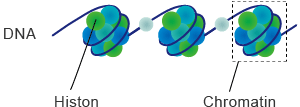In the previous chapter, it is explained that the protein can be formed when the genomic switch turns "ON". Then the question is, "How the genomic switch turns "ON" ? At present, many researchers in the world are studying the "switching mechanism". The study seeking the mechanism of genomic switching is called "Epigenetics". The epigenetic changes are defined as "modification of genomes without change of genomic sequences". A typical example of epigenetic change is the differentiation of zygote into various tissue cells (see the picture in Chapter 1 ).
Throughout the epigenetic studies, it becomes evident that these epigenetic changes are also closely related to the "acquired diseases" such as cancer, aging, and various metabolic syndromes.
In order to understand epigenetics, it is necessary to know how genomes exist in the cell. All the organs of our body consist of the cells which contain the genomes inherited from our parents.
 |
In the center of the cell, there is a "nuclei" where the genomes are located. The DNA is held with the DNA binding protein called "histon" and is packed within the nuclei. In general, the histon consists of pairs of four different proteins (total of 8 proteins), around which DNA is wrapped to form "chromatin". A chromatin is surrounded with approximately 150 base pairs of DNA. |
By the results of epigenetic studies, it has become clear that genomic switching is related to the shape of chromatin. As shown in the following picture, switching becomes "OFF" when the chromatin is "condensed". As a result, the gene becomes "silent" and no protein is produced. On the contrary, switching becomes "ON" when the chromatin is "opened". The gene is activated and messenger RNA is produced which leads to the synthesis of protein.
Furthermore, it has been proved that change of the shape of chromatin is caused by the chemical modification of histon and DNA. For example, when histon is methylated, chromatin becomes "condensed" (switching OFF), and when histon is acetylated, chromatin becomes "opened" (switching ON).
On the other hand, when DNA (which is wrapped around histon) is methylated, switching becomes "OFF". Therefore, it is apparent that both "histon modification" and "DNA modification " play an important role in switching.

Our whole genomes are inherited from our parents and remain unchanged throughout the whole life. However, the change of shape of chromatin due to the chemical modification does not involve the change of genomic sequence.
This process is called "epigenetic change". Therefore, although our whole genomic sequences remain unchanged, our gene expressions vary in time because of the epigenetic change ,which results in difference of the protein production with respect to the quality and the quantity. Recent investigations suggest that some of the acquired diseases such as cancer may be caused by these epigenetic changes.
These facts are very important, because it has long been considered that our constitution (the nature of our body) remains unchanged throughout the whole life, because our whole genomes are inherited from our parents. In fact, a certain type of inherited constitution has a tendency of causing a specific disease like "obesity" or "cancer", and it is believed that "tendency" of the inherited constitution would remain unchanged in the whole life. However, the "acquired constitution (the post-natal nature of our body)" is closely related to the gene expression which is caused by the epigenetic changes.
This is very encouraging. Because even though we inherit the original constitution from our parents, we still have a chance to alter the acquired constitution. Recently, it has become clear that these changes in gene expressions are related to our daily life style like nutrition, exercise, stress, etc.
For example, "oncogenes" are known as the genomic sequences which lead to cancer formation, and "suppressor genes" are known as the genomic sequences which can suppress cancer formation. Even though one has inherited active oncogenes, if switching of oncogenes become "OFF", or if switching of suppressor genes become "ON", oncogenes would be never activated. Thus, epigenetic changes are very important to determine our "acquired institution" by changing the gene expressions.
With advances in epigenetic studies, a possibility of creating a new therapy called "preventive medical treatment" is expected. The new therapy will be effective to prevent "acquired diseases" by controlling gene expression patterns in our daily life. The epigenetic studies concerning the cause of acquired diseases are in progress and a new therapy will be realized in the near future.







